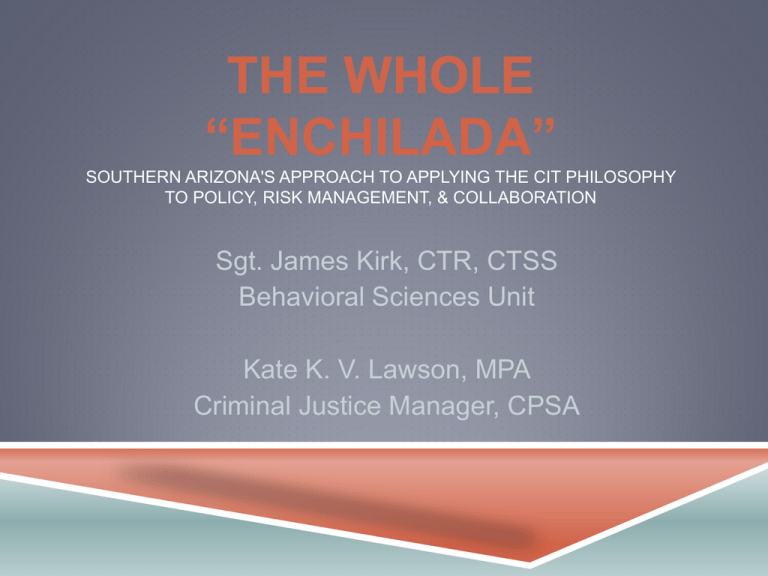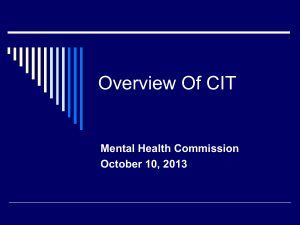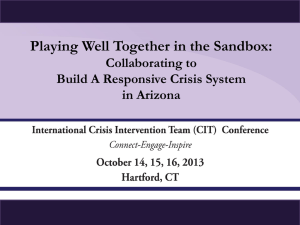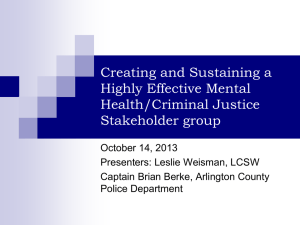the whole enchilada - CIT International Conference
advertisement

THE WHOLE “ENCHILADA” SOUTHERN ARIZONA'S APPROACH TO APPLYING THE CIT PHILOSOPHY TO POLICY, RISK MANAGEMENT, & COLLABORATION Sgt. James Kirk, CTR, CTSS Behavioral Sciences Unit Kate K. V. Lawson, MPA Criminal Justice Manager, CPSA SGT. JAMES KIRK Tucson Police Department Behavioral Sciences Unit Critical Incident Stress Management, Peer Support Lots of experience A couple more promotions and he’ll get to fly the Enterprise KATE LAWSON Criminal Justice Manager in the Regional Behavioral Health Authority It’s like an HMO for publically funded behavioral healthcare Liaison between mental healthcare and Criminal Justice (Courts, Jail, Probation, and Law Enforcement) Husband, Father, Uncle and Cousin are all police officers Just ask me about the helicopter BIG PICTURE It all started with CIT Collaboration…. …but grew to be something more Philosophical approach Mental health collaboration MAKES SENSE Reduces liability Improves officer safety Service to the community Saves taxpayer dollars (jail days, lawsuits, etc) Don’t stop at CIT Training… apply it to all situations THE REASON FOR CIT PHILOSOPHY: Two Rules Of Police Work1. Come home at the end of the day. 2. Have a home to come back to. REAL LIFE CASE EXAMPLE OFFICER SAFETY BULLETIN TUCSON POLICE DEPARTMENT ROBERTO A.VILLASEÑOR, CHIEF OF POLICE 270 S. STONE, TUCSON, ARIZONA 85701-1917 CASE NUMBER: 1105280796 DETAIL: ODW / NCS DATE: August 8, 2011 Officer Safety “BB” DOB / 021772 6’04” / 230 lbs shaved head / blue eyes LKA : 8500 E. Old Spanish Tr. #16 Tsn Blackwell has recently been in contact with detectives from T2 Neighborhood Crimes and he has made statements of concern. He is upset over a failed relationship and blames everyone from the police to the judge for his current situation. He has not made threats to any one individual, but he has expressed his anger and desires to see certain people dead. Officer Safety: Officers coming into contact with Balckwell should use extreme caution Approved by: _Sgt. Wheeler #31069 _____ CONFIDENTIAL - THIS INFORMATION IS RESTRICTED TO LAW ENFORCEMENT ONLY! COPS IN NUDE TASER SLAY - BROOKLYN DEATH PLUNGE - YouTube.mht COPS IN NUDE TASER SLAY - BROOKLYN DEATH PLUNGE - YouTube.mht The Brooklyn Case IMPORTANT… INTERNAL & EXTERNAL Community Mental Health Officer Safety Risk Management Community Service Cost Savings Officer Well-Being Keeping “good officers good” Resiliency Trauma inoculation Job/Personal life balance …its not just about serving the mental health needs of the community, but the officers too MORE IMPORTANT NOW THAN EVER: THE ECONOMY & CRIMINAL JUSTICE Impact of the economy of community treatment means more mental health issues for officers to encounter Numbers in all courts increasing Members who have never been involved in justice system before SYMBIOTIC RELATIONSHIP: HOW COLLABORATION BENEFITS TPD Good community service Helps to break cycle—fix problem once rather than a nightly occurrence Improve the community Mitigate liability Reduce risk of harm to officer or individual Cost savings Jail Cost: First day $280, Every day thereafter $180 Pre-CPSA: ALOS for MH case 21 days, Now is 3 days Court Costs (+Officer Time) SYMBIOTIC RELATIONSHIP: HOW COLLABORATION BENEFITS CPSA Service to our members Fewer criminal charges Focus on treatment and recovery rather than crisis and jail Leverage justice system (like diversion courts) to encourage compliance with treatment Results in meaningful, long-term recovery Use of less costly resources Fewer inpatient hospital admissions, etc Community solution based Good for the goose… …good for PR THE PHILOSOPHY “Whole Enchilada” philosophy of CIT… 40 hours is just the start, but it must go beyond Top down, and bottom up implementation of the philosophy Get buy-in from command staff, but also patrol officers as well Building relationships = Extend the philosophy outside the department Community mental health & Law Enforcement, but also Advocacy groups Philosophy and relationships evolve and grow THE ACTUALIZATION CIT Training – The Start Advanced CIT Training Presentation/Collaboration with Command Staff Overall integration, consideration in all policies and procedures Incorporate into long-term planning Integration of Law Enforcement with Crisis System Crisis Response Center (CRC) / Crisis Response Network (CRN) MAC Teams / SAMHC Cop Culture Class for Mental Health Professionals Advocacy Groups (NAMI Family to Family) Tactical/Behavioral Response Training Integration with Overall Justice System Courts (Mental Health Courts), Jail, Probation and others THE NUTS AND BOLTS… HOW DO WE MAKE THIS WORK? 1. Identify the Players (Needed Organizations) What resources do you need to bring to the table? Law Enforcement Courts Community Mental Health Treatment—different in every area, find out who manages Medicaid-funded behavioral health in your area 2. Find the Game Changers Folks who “get it” and are willing to change minds Law Enforcement—Need a “Traditional Philosophy” mindset 3. Identify Each Agency’s Needs Next Slide HOW DO YOU GET BUY-IN? A BASIC ECONOMY LESSON People are driven by needs Why I think mental health criminal justice collaboration isn’t important… …it’s why you SHOULD think it’s important Avoid the “Touchy Feely” Argument What’s important to Law Enforcement? To Behavioral Health Providers? Usually RISK MANAGEMENT Think about ways various players can gain from adopting philosophies, changing policies, and collaborating with unlikely partners Next Slide- EXAMPLES NEEDS-BASED ARGUMENTS Law Enforcement: “Compassion based” arguments not as successful as risk management/liability and officer safety persuasion Behavioral Health intro during CIT Week Patrol Officer Appeal: “Longer Lunch” when you avoid going hands on right away (less paperwork). “Time is on your side”—we train to go hands on right away, see if you can talk your way into the solution. Officer safety, and reduction of liability (“Even if you have to use force, easier to justify to a defense later on”) Behavioral Health: Many say “if they’ve done something wrong they should go to jail”… but they don’t STAY in jail; argue for long term recovery (= less hospitalization), and risk management WHY CPSA HAS A CRIMINAL JUSTICE TEAM: Invaluable service to members (Clients) Increase treatment compliance Resolve criminal charges Improve public safety Treatment compliance = fewer offenses Intervention before offense occurs Being “on the radar” before negative event Saves taxpayer/system dollars Stable treatment results in fewer incarcerations, hospitalizations, and Involuntary Commitment requests COP CULTURE Traditional “Cop Philosophy” regarding mental health Has left officers vulnerable: Their safety, citizen safety, and opportunity for win-win outcomes Our view of criminal behavior by those with mental illness (DV example) How we have responded to EDP in the past Memphis CIT/ Lucas Glenn “Speedway Randy” How we are changing “Cop Culture” CIT Training, Advanced CIT, Collaboration with MH, involve in the solutions/case management… help to change the culture How we train Mental Health on “Cop Culture” Trainings with Community Mental Health Treatment/Crisis Providers BEHAVIORAL HEALTH STAFF: BE “COP CULTURE COMPETENT” Use the law enforcement “vernacular” Make “needs based” appeals for buy-in Avoid judgment for past decision-making Especially if disclosed with intentions of getting advice Take the time to learn the system Ride-alongs, officer interviews, etc Problem-solve with or for them, don’t just direct them to the right resources Explain the “big picture” (they only see a sliver) LAW ENFORCEMENT: BE “TREATMENT CULTURE COMPETENT” Try to learn the “big picture” (ie what happens to someone after you drop them off at the hospital, etc) Be open to trying it a new way (taking someone to a psychiatric urgent care center rather than the jail) Communicate your needs: treatment community may not see what you’re seeing when it comes to an individual—be specific about what is happening… …and then be part of the solution The CIT “Philosophy” Now Reflected in Court Rulings LEGAL UPDATES COURT CASES INFLUENCING RISK MANAGEMENT & ENCOURAGING “CIT PHILOSOPHY” A Pattern of Court Cases that point to a change in philosophy… Graham v. Conner Quezada v. County of Bernalillo Deorle v.Rutherford Glenn v. Washington County GRAHAM V. CONNER 1989 “The "reasonableness" of a particular use of force must be judged from the perspective of a reasonable officer on the scene, rather than with the 20/20 vision of hindsight. . . . With respect to a claim of excessive force, the same standard of reasonableness at the moment applies: "Not every push or shove, even if it may later seem unnecessary in the peace of a judge's chambers,. . . violates the Fourth Amendment.” A more recent video example of the “reasonableness” guideline GRAHAM V. CONNER 1989 “The calculus of reasonableness must embody allowance for the fact that police officers are often forced to make split-second judgments--in circumstances that are tense, uncertain, and rapidly evolving--about the amount of force that is necessary in a particular situation.” QUEZADA V. COUNTY OF BERNALILLO, NEW MEXICO, 10TH CIRCUIT 1991 COURT’S DECISION Trial Court awarded $1.24 million to Quezada’s family for Title 42 1983 violations and negligence 10th Appellate Court reversed & remanded the civil rights violation back to trial court. Negligence judgment affirmed (Failure to train…mental health issues) COURT’S REASONING “Sauser placed himself in great jeopardy by standing in the open and close to Griego’s car. His vulnerable location left deadly force as the only option…. “He amplified the risk of harm to Griego.” “Deputy Sauser created the danger that lead to the use of deadly force.” DEORLE V.RUTHERFORD Occurred in September 1996 in Butte County, California (Chico) March 2001 9th Circuit Ruling BUTTE COUNTY, CALIFORNIA DEORLE V.RUTHERFORD “The problems posed by, and thus the tactics to be employed against, an emotionally distraught individual who is creating a disturbance or resisting arrest are, and must be, differentiated from those involved in efforts to subdue an armed and dangerous criminal who has recently committed a serious offense. DEORLE V.RUTHERFORD “In the former case, increasing the use of force may, in a number of circumstances, exacerbate the situation; in the latter instance, a heightened us of less-than-lethal force will ordinarily be helpful in bringing a dangerous situation to an end.” DEORLE V.RUTHERFORD “In the case of mentally unbalanced persons, the use of officers and others trained in the art of counseling is ordinarily advisable…” “… Even when an EDP is acting out and inviting officers to us deadly force to subdue him, the governmental interest in using such force is diminished by the fact that the officers are confronted not with a criminal, but with a mentally ill person” DEORLE V.RUTHERFORD Paraphrasing the Court…. “We’re not telling you you to treat EDP’s different, but that is what we expect from you” OR….. “Don’t expect us to uphold summary judgments when you don’t differentiate. (I.e., “the rules have changed”) GLENN V. WASHINGTON COUNTY Occurred in Hillsboro, Washington County, Oregon in 2006 9th Circuit Opinion published in November 2011 GLENN V. WASHINGTON COUNTY Court’s decision…. “…we have made it clear that the desire to quickly resolve a potentially dangerous situation is not the type of governmental interest…that justifies the use of force that may cause serious injury (Deorle).” “We also recognized in Deorle, that when dealing with EDP’s who is creating a disturbance or resisting arrest, as opposed to a dangerous criminal, officers typically use less forceful tactics.” (notice the change in language) GLENN V. WASHINGTON COUNTY “ The facts in this case, viewed in the light most favorable to the plaintiff, bear this out: Lukus did not respond positively to the officers’ forceful tactics, and just before officers fired the beanbag gun, Lukus pled, “Tell them to stop screaming at me’” and “why are you yelling?” The Family hired a Subject Matter Expert, a former Bellevue, Washington Chief of Police. His professional opinion forms the basis for what should be our response to these situations with EDP’s… (NEXT SLIDE) CRISIS INTERVENTION PHILOSOPHY 1) Slow it down, 2) Do not increase the subject’s level of anxiety or excitement, 3) Attempt to develop a rapport, 4) Time is on the side of the police GLENN V. WASHINGTON DIRECTION FROM THE COURT: The “objective reasonableness test” from Graham has changed with respect to EDP’s. The Court is clearly expecting a higher level of response from law enforcement. “Summary Judgments” are not automatic COURT RULINGS TO CIT PHILOSOPHY We don’t just do it because it’s “encouraged” by the courts… we know it’s not only ‘the right thing to do’ but it’s also the most LOGICAL thing to do DISCUSSION (WITH NO RIGHT ANSWER) Officer Erik Hite example January 8th Tucson Shooting Recent Aurora, CO shooting Where do we go from here? How can we use the “CIT Philosophy” to make improvements across the board (law enforcement, mental health treatment, and our communities at-large) to have early intervention with individuals who have a mental illness and are a danger to themselves or others? CONTACT INFO Sgt. Kirk: (520) 837-8885 James.Kirk@tucsonaz.gov Kate Lawson (520) 322-4107 Kate.Lawson@cpsa-rbha.org THANK YOU!









